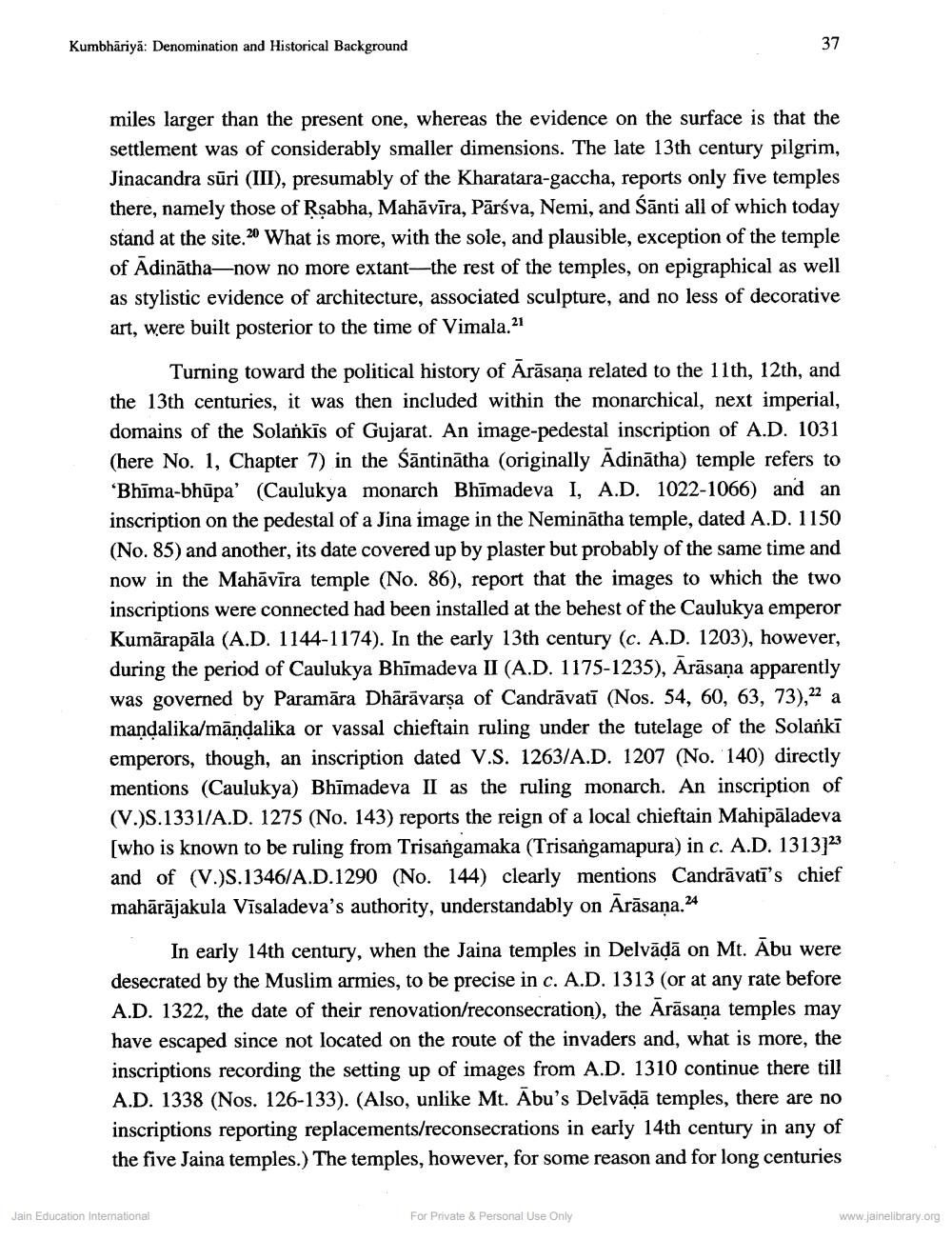________________
Kumbhāriya: Denomination and Historical Background
37
miles larger than the present one, whereas the evidence on the surface is that the settlement was of considerably smaller dimensions. The late 13th century pilgrim, Jinacandra sūri (III), presumably of the Kharatara-gaccha, reports only five temples there, namely those of Rşabha, Mahāvīra, Pārsva, Nemi, and Sānti all of which today stand at the site.20 What is more, with the sole, and plausible, exception of the temple of Adinātha—now no more extant—the rest of the temples, on epigraphical as well as stylistic evidence of architecture, associated sculpture, and no less of decorative art, were built posterior to the time of Vimala. 21
Turning toward the political history of Arāsana related to the 11th, 12th, and the 13th centuries, it was then included within the monarchical, next imperial, domains of the Solankīs of Gujarat. An image-pedestal inscription of A.D. 1031 (here No. 1, Chapter 7) in the śāntinātha (originally Ādinātha) temple refers to "Bhīma-bhūpa' (Caulukya monarch Bhīmadeva I, A.D. 1022-1066) and an inscription on the pedestal of a Jina image in the Neminātha temple, dated A.D. 1150 (No. 85) and another, its date covered up by plaster but probably of the same time and now in the Mahāvīra temple (No. 86), report that the images to which the two inscriptions were connected had been installed at the behest of the Caulukya emperor Kumārapāla (A.D. 1144-1174). In the early 13th century (c. A.D. 1203), however, during the period of Caulukya Bhīmadeva II (A.D. 1175-1235), Arāsaņa apparently was governed by Paramāra Dhārāvarsa of Candrāvatī (Nos. 54, 60, 63, 73),22 a mandalika/māndalika or vassal chieftain ruling under the tutelage of the Solanki emperors, though, an inscription dated V.S. 1263/A.D. 1207 (No. 140) directly mentions (Caulukya) Bhīmadeva II as the ruling monarch. An inscription of (V.)S.1331/A.D. 1275 (No. 143) reports the reign of a local chieftain Mahipāladeva [who is known to be ruling from Trisangamaka (Trisangamapura) in c. A.D. 1313123 and of (V.)S.1346/A.D.1290 (No. 144) clearly mentions Candrāvatī's chief mahārājakula Visaladeva's authority, understandably on Arāsana.24
In early 14th century, when the Jaina temples in Delvādā on Mt. Ābu were desecrated by the Muslim armies, to be precise in c. A.D. 1313 (or at any rate before A.D. 1322, the date of their renovation/reconsecration), the Arāsaņa temples may have escaped since not located on the route of the invaders and, what is more, the inscriptions recording the setting up of images from A.D. 1310 continue there till A.D. 1338 (Nos. 126-133). (Also, unlike Mt. Abu's Delvādā temples, there are no inscriptions reporting replacements/reconsecrations in early 14th century in any of the five Jaina temples.) The temples, however, for some reason and for long centuries
Jain Education International
For Private & Personal Use Only
www.jainelibrary.org




